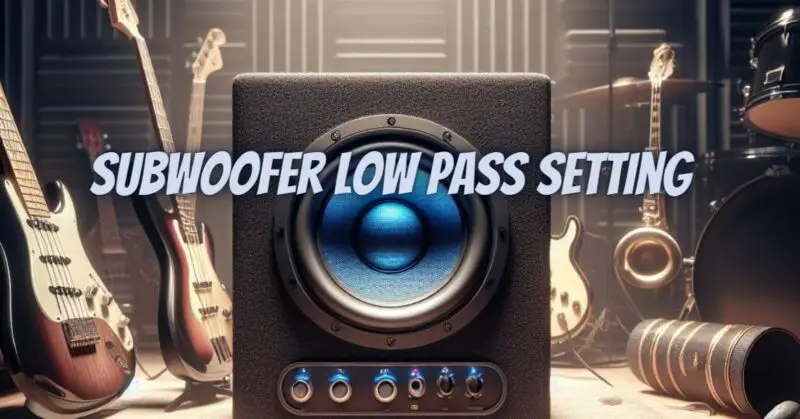The subwoofer low pass setting, also known as the crossover frequency, is a filter that separates the audio signal into two frequency ranges: low frequencies that are sent to the subwoofer, and high frequencies that are sent to the main speakers. This is done to ensure that the subwoofer is only reproducing the frequencies that it can handle well, while the main speakers are reproducing the higher frequencies.
Why is the subwoofer low pass setting important?
The subwoofer low pass setting is important because it can affect the overall sound quality of your system in a number of ways. First, it can help to ensure that the bass is reproduced in a balanced and accurate way. Second, it can help to prevent the subwoofer from being overloaded, which can lead to distortion. Third, it can help to improve the overall clarity and definition of the soundstage.
How to choose the right subwoofer low pass setting
The best subwoofer low pass setting will vary depending on a number of factors, including the size and type of your main speakers, the size of your room, and your personal preferences. However, there are some general guidelines that you can follow.
- For home theater systems, the most common subwoofer low pass setting is 80 Hz. This is a good starting point for most systems, but you may want to adjust it up or down depending on your setup.
- If you have small main speakers, such as bookshelf speakers, you may want to set the subwoofer low pass frequency a bit higher, to 100 Hz or even 120 Hz. This will prevent the main speakers from trying to reproduce frequencies that they are not well-suited for, which can lead to distortion.
- If you have large main speakers, such as tower speakers, you may want to set the subwoofer low pass frequency a bit lower, to 60 Hz or even 40 Hz. This will allow the main speakers to reproduce more of the bass frequencies, which can result in a more powerful and immersive soundstage.
How to adjust the subwoofer low pass setting
Most subwoofers have a subwoofer low pass setting control on the back. Simply turn the knob until you reach the desired frequency. You can also adjust the subwoofer low pass setting in your receiver’s audio settings menu.
Tips for finding the best subwoofer low pass setting
- Start with the subwoofer low pass frequency set to 80 Hz. This is a good starting point for most systems.
- Play some music or movies that you are familiar with. Listen carefully and try to identify the point where the bass sounds the best. If the bass sounds boomy or overpowering, try lowering the subwoofer low pass frequency. If the bass sounds weak or lacking, try raising the subwoofer low pass frequency.
- You can also use a test tone generator to find the best subwoofer low pass setting. This is a tool that generates a single frequency tone. Start with the test tone set to 80 Hz and then adjust it up or down until you find the frequency where the bass sounds the best.
Once you have found the best subwoofer low pass setting, be sure to write it down. This will make it easier to adjust the subwoofer low pass frequency in the future if you change your system or move to a new room.
Additional tips
- In addition to the subwoofer low pass frequency, you may also want to adjust the subwoofer’s gain. The gain control determines how loud the subwoofer is relative to the main speakers. Start with the gain set to a low level and then gradually increase it until the bass sounds balanced with the rest of the system.
- You may also want to experiment with different crossover slopes. The crossover slope determines how quickly the audio signal is rolled off above or below the crossover frequency. A steeper slope will result in a more precise transition between the subwoofer and the main speakers, while a gentler slope will result in a more gradual transition.
- Ultimately, the best subwoofer low pass setting for your system is the one that sounds the best to you. Experiment with different settings and find what works best for your system and your room.
The subwoofer low pass setting is an important factor to consider when setting up your home theater or audio system. By following the tips above, you can find the best subwoofer low pass setting for your system and enjoy the best possible sound quality.


